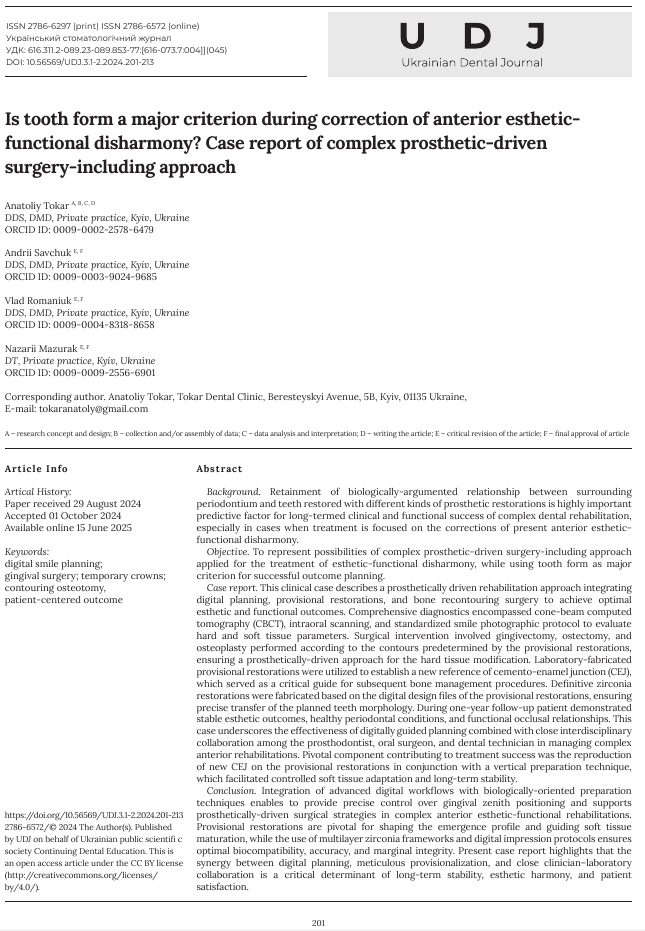Is tooth form a major criterion during correction of anterior esthetic-functional disharmony? Case report of complex prosthetic-driven surgery-including approach
DOI:
https://doi.org/10.56569/UDJ.3.1-2.2024.201-213Keywords:
digital smile planning, gingival surgery, temporary crowns, contouring osteotomy, patient-centered outcomeAbstract
Background. Retainment of biologically-argumented relationship between surrounding periodontium and teeth restored with different kinds of prosthetic restorations is highly important predictive factor for long-termed clinical and functional success of complex dental rehabilitation, especially in cases when treatment is focused on the corrections of present anterior esthetic-functional disharmony.
Objective. To represent possibilities of complex prosthetic-driven surgery-including approach applied for the treatment of esthetic-functional disharmony, while using tooth form as major criterion for successful outcome planning.
Case report. This clinical case describes a prosthetically driven rehabilitation approach integrating digital planning, provisional restorations, and bone recontouring surgery to achieve optimal esthetic and functional outcomes. Comprehensive diagnostics encompassed cone-beam computed tomography (CBCT), intraoral scanning, and standardized smile photographic protocol to evaluate hard and soft tissue parameters. Surgical intervention involved gingivectomy, ostectomy, and osteoplasty performed according to the contours predetermined by the provisional restorations, ensuring a prosthetically-driven approach for the hard tissue modification. Laboratory-fabricated provisional restorations were utilized to establish a new reference of cemento-enamel junction (CEJ), which served as a critical guide for subsequent bone management procedures. Definitive zirconia restorations were fabricated based on the digital design files of the provisional restorations, ensuring precise transfer of the planned teeth morphology. During one-year follow-up patient demonstrated stable esthetic outcomes, healthy periodontal conditions, and functional occlusal relationships. This case underscores the effectiveness of digitally guided planning combined with close interdisciplinary collaboration among the prosthodontist, oral surgeon, and dental technician in managing complex anterior rehabilitations. Pivotal component contributing to treatment success was the reproduction of new CEJ on the provisional restorations in conjunction with a vertical preparation technique, which facilitated controlled soft tissue adaptation and long-term stability.
Conclusion. Integration of advanced digital workflows with biologically-oriented preparation techniques enables to provide precise control over gingival zenith positioning and supports prosthetically-driven surgical strategies in complex anterior esthetic-functional rehabilitations. Provisional restorations are pivotal for shaping the emergence profile and guiding soft tissue maturation, while the use of multilayer zirconia frameworks and digital impression protocols ensures optimal biocompatibility, accuracy, and marginal integrity. Present case report highlights that the synergy between digital planning, meticulous provisionalization, and close clinician–laboratory collaboration is a critical determinant of long-term stability, esthetic harmony, and patient satisfaction.
Ethical aspects
Authors confirm that they have followed all relevant ethical norms and requirements during the treatment described within present case report and preparation of present manuscript. Authors obtained full patient’s agreement regarding publication of following case report, and such was approved by corresponding consent form signed by the patient personally. No information in present case report may disclose any personal data about the patient, which further may be used for patient’s personal identification. Any information related to patient’s identity disclosure was either deleted or anonymized within present case report.
Authors confirm that they have followed CARE guidelines while preparing present case report with intention for further publication.
Conflict of Interest
Author does not have any potential conflict of interests that may influence the decision to publish this article.
Funding
No funding was received to assist in preparation and conduction of this research, as well as in composition of this article.

Downloads
Published
Issue
Section
Categories
License
Copyright (c) 2024 The Author(s)

This work is licensed under a Creative Commons Attribution 4.0 International License.








